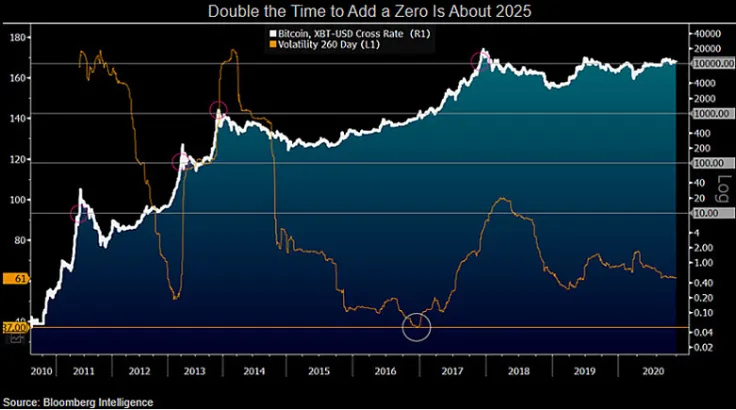
Mike McGlone, a senior commodity strategist for Bloomberg Intelligence, remains relentlessly bullish on Bitcoin.
In his cryptocurrency outlook for October—McGlone has shared the main highlights in a recent tweet—the analyst claims that the leading cryptocurrency is on pace to touch $100,000 in 2025.

Bitcoin's maturation into digital gold
Channeling venture capitalist Tim Draper, McGlone expects increasing adoption to be the main catalyst for appreciation.
Its ascent to the six-digit reality would be a slow grind rather than the overnight moonshot that the community expects.
In the September outlook, McGlone made a wild prediction that Bitcoin's limited supply of 21 mln coins and growing demand could eventually push "digital gold" to $500,000 without specifying an exact timeframe.
The benchmark crypto has won the adoption race among myriad copycats and is maturing into a digital version of gold.
Morning Crypto Report: Ex-Ripple CTO Reveals Unknown XRP Story From 2013, Shiba Inu (SHIB) Rockets 30% in $12 Billion Meme Coin Comeback, Legendary Trader Suddenly Becomes Bitcoin Cash BullSchiff Dismisses Bitcoin Rally as BTC Reclaims $93KShiba Inu (SHIB) Price Prediction 2026Crypto Market Review: Shiba Inu (SHIB) Wants Zero Removed, XRP's Critical 2026 Resistance Destroyed, Bitcoin Needs 2 More Moves Before $100,000
At this point, the cryptocurrency that started it all would supersede the current market cap of actual gold that currently stands at around $8 tln.
Bitcoin reached its peak market cap of roughly $326 bln on Dec. 17, 2017, before dwarfing to just $60 bln in December 2018 during the brutal crypto winter.
Not that bullish on Ethereum
Bitcoin was the best-performing asset of the previous decade, but investors should be wary of the fact that past returns are not necessarily indicative of Bitcoin's future performance.
The rival Ethereum community, for example, routinely slams Bitcoin as the "boomer coin" and the AOL of crypto that will fail the test of the 2020s and cede its ground to other coins.
Drawing parallels with the dot-com bubble of the late 1990s, McGlone claims that Bitcoin will come out on top while predicting that the Tether stablecoin is going to pass Ethereum's market cap in 2021.
It should take something significant to stall the increasing adoption of Tether, the top stable coin, which is on pace to match the capitalization of Ethereum in a bit less than a year, based on the regression trend since the start of 2019.
Advertisement

 Arman Shirinyan
Arman Shirinyan Tomiwabold Olajide
Tomiwabold Olajide Gamza Khanzadaev
Gamza Khanzadaev Godfrey Benjamin
Godfrey Benjamin Yuri Molchan
Yuri Molchan